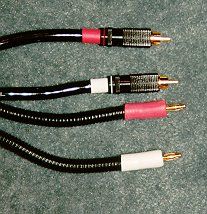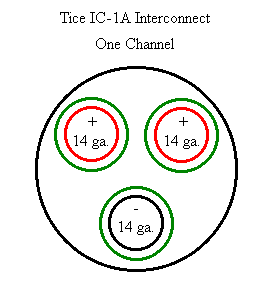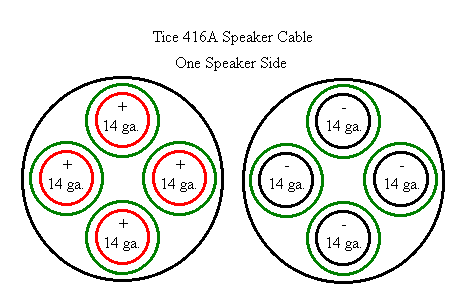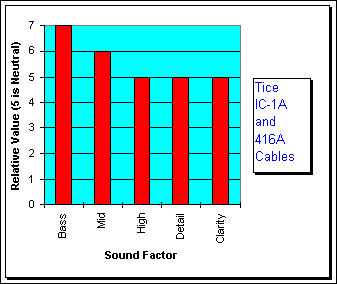Product Review -
Tice Audio Interconnects - October, 1996
By John E. Johnson, Jr.
![]()
 |
Tice Audio Products, 1530 Cypress Drive, Suite C Jupiter, Florida 33469 Phone 561-575-7577; Fax 561-575-0302
Tice Audio Interconnects and Speaker Cables; IC-1A Interconnects; $450/meter pair, terminated with RCA plugs; 416A Speaker Cables; $752/ 8 foot pair, terminated with spades or banana plugs; 30 Day Money Back and Lifetime Warranty;
George Tice is famous for his innovative AC line conditioner designs, such as the venerable Power Block III [Click here to see review]. Less known are his new interconnects and speaker cables, but, you know, I think he is going to be famous for these too . . . and soon. Why? Because he is compulsive. Instead of using 50 cent capacitors in his line conditioners, he uses the 4 dollar ones. He can hear not only differences in various brands of parts, but differences in the manufacturing run of the same part! I am not sure I would want my ears to be that sensitive, but I am convinced that this guy knows what he is doing, and that we can benefit from his meticulous nature.
The first thing I noticed about the cables
we received for review, is that they are stiff. This is due to
the use of very heavy OFC solid core copper conductors. In the
case of the IC-1As, there are three conductors (14 gauge),
arranged side by side in each cable, but not twisted.  George's feeling is that twisting the conductors
produces more interaction between them, adding fuzziness to the
sound. The 416As have eight 14 gauge conductors in each cable. The conductors are surrounded by TFE dielectric,
which is similar to Teflon, except that the TFE has small air
bubbles. Air (or actually, vacuum) provides the best dielectric,
so the combination of the TFE and air, gives an excellent
protection to the smear effect that results from storage and
release of electrons in lesser quality dielectric insulation.
Besides the TFE, Tice applies a heat bonded, glued shrink wrap,
around each conductor, so that oxidation of the copper is
prevented.
George's feeling is that twisting the conductors
produces more interaction between them, adding fuzziness to the
sound. The 416As have eight 14 gauge conductors in each cable. The conductors are surrounded by TFE dielectric,
which is similar to Teflon, except that the TFE has small air
bubbles. Air (or actually, vacuum) provides the best dielectric,
so the combination of the TFE and air, gives an excellent
protection to the smear effect that results from storage and
release of electrons in lesser quality dielectric insulation.
Besides the TFE, Tice applies a heat bonded, glued shrink wrap,
around each conductor, so that oxidation of the copper is
prevented.
Sound wise, these cables are superb. A lot
of music on CDs is a bit harsh. Sometimes, we don't really notice
this consciously, but we end up turning the hifi off after 20
minutes, or leaving the room, not really knowing why or even
thinking about it. The slight harshness is one major reason, and
the Tice cables have none. It may be due to the conductor
configuration in part, but I have heard other solid core cables,
and they did not sound like this. Well, then, it must be the
proprietary TPT treatment that George applies to each of his
products, including these cables. I don't know what TPT is, but I
don't care.  The Tice formula works. That's the bottom line.
Although there is no harshness, detail and clarity remain, which
is quite an accomplishment. It's not like he just turned the
treble control down to reduce the tizziness at the top end. Much
more complicated, I think.
The Tice formula works. That's the bottom line.
Although there is no harshness, detail and clarity remain, which
is quite an accomplishment. It's not like he just turned the
treble control down to reduce the tizziness at the top end. Much
more complicated, I think.
The mid-range is very full bodied with
these cables. At first, this made me a little nervous, because
full bodied mids often bring a chesty quality to the human voice,
but this was not the case with the Tice cables. The mids are
indeed a little above neutral, but it is
pleasant, which is a nice surprise.  The bass is incredibly deep.
We have some speakers with great mids and highs, but kind of a
loose bass, and the 416As tightened the bass up and deepened it.
We used the Tice cables with our McCormack transport and DAC, the
Audio Alchemy system, McCormack preamp, AE-1 preamp, NAD 208
power amp, White Audio power amps, Sunfire power amp, Vista
electrostatic speakers, Ambience ribbon speakers, Osborn cone
speakers, and Carver ribbon speakers (see reference
component section for details).
The bass is incredibly deep.
We have some speakers with great mids and highs, but kind of a
loose bass, and the 416As tightened the bass up and deepened it.
We used the Tice cables with our McCormack transport and DAC, the
Audio Alchemy system, McCormack preamp, AE-1 preamp, NAD 208
power amp, White Audio power amps, Sunfire power amp, Vista
electrostatic speakers, Ambience ribbon speakers, Osborn cone
speakers, and Carver ribbon speakers (see reference
component section for details).
Assuming that TPT treatment involves high pressure, these cables as received by the consumer, will consist of mostly single crystal copper. In order not to increase the number of crystal grain boundaries (which could affect signal transmission), these cables should not be bent at sharp angles, not twisted, not stepped on. Of course, no audio cable should be mistreated, but these are expensive high quality components that should be handled with the same care as the CD player, amp, and speakers.
In summary, I was pleasantly surprised at how good these cables are. You may need to order the 1.5 meter interconnects so that there will be enough length to connect them without bending them at sharp angles (no tighter bend than around a ping pong ball). Also, you can save 40 - 50% on the list price by ordering factory direct (U.S. and Canada only). Highly recommended.
John E. Johnson, Jr.
Editor
![]()
© Copyright 1995, 1996, 1997
Secrets of Home Theater & High Fidelity
Return to Table of Contents for this Issue.

